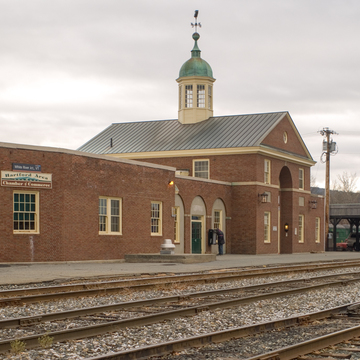You are here
White River Junction Amtrak Station (Union Station)
The intersection of five railroads—the Vermont Central (1847), the Connecticut River (1847), the Connecticut and Passumpsic Rivers (1848), the New Hampshire Central (1849), and the Woodstock (1875)—made White River Junction a major passenger exchange point. The first three depots to serve the junction (1862, 1880, 1911) were all destroyed by fire. The current (fourth) station was built by two successor railroads, the Central Vermont and the Boston and Maine. Larson designed the station in Colonial Revival, the style he favored. The brick depot has an octagonal domed cupola with a locomotive weathervane on its pedimented central block and a dominant arched recess framing the entrance. A stringcourse at the springing of the arch extends to tie in single-story wings that serve as baggage storage and waiting room. Vermont's only Colonial Revival railroad depot, in use today by Amtrak, represents the last station of significant architectural quality that private railway companies built in the state.
Writing Credits
If SAH Archipedia has been useful to you, please consider supporting it.
SAH Archipedia tells the story of the United States through its buildings, landscapes, and cities. This freely available resource empowers the public with authoritative knowledge that deepens their understanding and appreciation of the built environment. But the Society of Architectural Historians, which created SAH Archipedia with University of Virginia Press, needs your support to maintain the high-caliber research, writing, photography, cartography, editing, design, and programming that make SAH Archipedia a trusted online resource available to all who value the history of place, heritage tourism, and learning.















